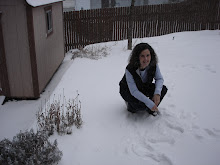The first is a machine that makes big, round bales - 58" to be exact. The machine is hooked up to the tractor - 10 hydraulic hoses involved among other things - and driven over rows of cut hay that has been raked into "windrows" and the machine picks it up and magically makes a bale by chopping and rolling it and wrapping it in plastic netting. Then it pops it out the back end, kind of like a chicken laying an egg. Actually, this particular one is new and extremely fancy schmancy. There isn't a picture of the finished product. Have to get on that and post it later.
Yes, that is the Poster Child running along with them. She will lap the field indefinitely with my dad, her hero.
This is the square baler which makes roughly, 2' x 1.5' x 4' bales that weigh maybe 40-50 lbs.
 This is an extremely tedious and labor intensive process. It requires strong men with good endurance and in good health, especially since it is often done for hours and hours on the hottest possible days of the year. This one particular farm activity is probably just about my least favorite, and was a frequent summer job of mine (though I got the easy end of the deal - driving the tractor). A tractor pulls the baler and wagon round and round the field scooping up hay, packing it into bales, tying it with twine, and tightly stacking it by hand on the wagon to be taken to the barn where it is unloaded and restacked, in endless repitition till the field is cleared. It is often done in a marathon as one is always trying to squeeze the whole process in between rainstorms. And here is another one of the "vintage" items I mentioned - that tractor. My dad could tell you every detail about it including what year it was made, but it has been here since I was wee little, which was quite a long time ago, nearly four decades, and more than likely wasn't "new" then. Geoff, little G, B and L are riding on the spare wagon.
This is an extremely tedious and labor intensive process. It requires strong men with good endurance and in good health, especially since it is often done for hours and hours on the hottest possible days of the year. This one particular farm activity is probably just about my least favorite, and was a frequent summer job of mine (though I got the easy end of the deal - driving the tractor). A tractor pulls the baler and wagon round and round the field scooping up hay, packing it into bales, tying it with twine, and tightly stacking it by hand on the wagon to be taken to the barn where it is unloaded and restacked, in endless repitition till the field is cleared. It is often done in a marathon as one is always trying to squeeze the whole process in between rainstorms. And here is another one of the "vintage" items I mentioned - that tractor. My dad could tell you every detail about it including what year it was made, but it has been here since I was wee little, which was quite a long time ago, nearly four decades, and more than likely wasn't "new" then. Geoff, little G, B and L are riding on the spare wagon.With either one of these methods, it seems like the baling machine breaks on a regular basis. There are a lot of moving parts that get a lot of wear and tear involved, for example a knotter that ties the twine.
My dad has always raised Hereford/Polled Hereford beef cattle (which is what makes hay baling a necessity). Here are a few heifers and a bull.
Ah, lightning bugs - always a favorite aspect of our visits here.
We have been blessed with glorious weather here so far. It could be in the 90's with 95% humidity, but has been in the 70's and low 80's instead. Wonderful!
Here's little G, delighting in the opportunity to drive the riding lawn mower. He's 8, and driven a variety of things since we arrived here earlier this week.
The girls enjoying a favorite spot from my childhood. Besides swinging, I would often sit there and shell peas, or snap beans. My dad welded that swingset together out of pipe when I was little. Unfortunately, the big, beautiful old maple that shaded it in the afternoon, and was also the anchor for our "treehouse" had to be cut down last year.
I may have to give my parents the gift of a weed-eater before we leave here...







Hi Tiffani! thanks for stopping by my blog! I am an old farm boy - we use to put our hay up loose for many years. we would back the wagon into the barn and then use large hay hooks to pull the hay up and over then trip the hooks and the hay would fall into the hay mow. Then we got modern and used a square baler like the one in your picture.
ReplyDeleteGod bless! Papa
I know literally nothing about hay bailing, or at least I didn't know anything till I read your blog! :) Looks like you all are having a great time. Love the hair, by the way. *snark*
ReplyDelete